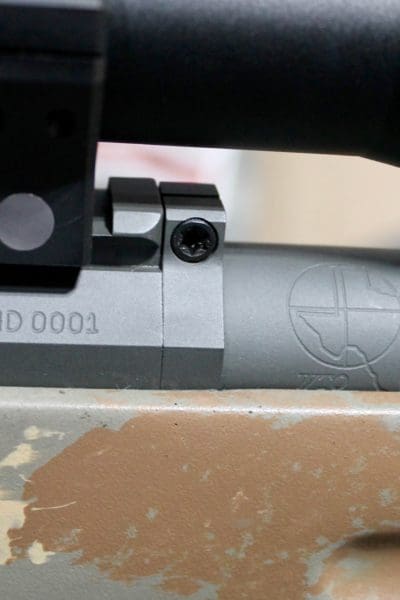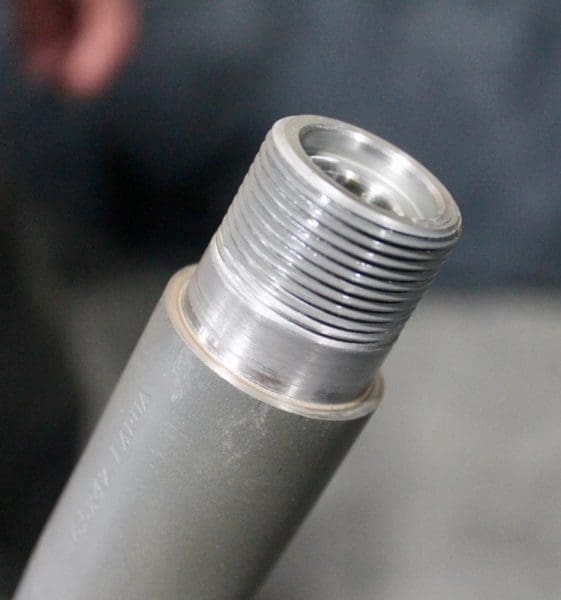
One of the most common things I kept running into at the 2017 SHOT show were rifles equipped for switching barrels quickly and with a minimum of tools. It seems to be all the rage today, and it shouldn’t come as a surprise. Investing in a really solid action, stock/chassis, and optic is a big chunk of change. And even though I love my heavy barreled .308, it wouldn’t be my first choice for a precision rifle competition. Similarly, hot 6 mm loads are the hotness this year with the introduction of the barrel burning 6 mm Creedmoor, so the ability to swap out for a new barrel without spending an arm and leg in labor is welcome.

Jonathan Rubio from West Texas Ordnance was sharing some space with the folks from Hawkins Precision and was nice enough to show me his SwitchLug setup. The SwitchLug replaces your traditional recoil lug, and allows the end user to swap barrels back and forth as necessary. At the moment, WTO’s lug is designed for most Remington 700 pattern actions as well as WTO’s Claymore HD and Stiller’s Spectre. He was happy to demonstrate a swap for me, and I was pleased to see that it took right at a minute for him to remove the old barrel and replace it with a new one. Simply loosen the Torx, unscrew the old barrel, screw in the new barrel hand tight, and tighten the Torx. All this without removing the scope. 
The SwitchLug will not work with a standard Remington 700 barrel as it requires a slightly larger diameter shoulder and a 1 degree taper. Due to the larger shoulder, it might be necessary to relieve a bit of material from the stock of your existing rifle as well. Due to the thicker diameter (.350″), Jonathan also advises that some stocks need to be opened up around the recoil lug and bedded. This is especially true for chassis rifles.
As to repeatability, Jonathan says that they see a maximum of +/- .5 MOA shift between the same barrel with some barrel/action setups doing much better. At $135 for the lug and $375 for the lug and labor to have WTO true your action, the SwitchLug is a fairly attractive option for those looking to turn their Remington 700 or similar into a true switchbarrel setup.




Ooh boy! Now you can get a Remington 700 action to unintentionally discharge in a variety of calibers.
Not to mention the engineering slop of a pinch-band with absolutely no lugs or threads between it and the barrel it’s supposed to affix. It’s what, 1/4″ wide? This is the guy that designed a cruise control that works by placing a cane between the accelerator pedal, and a mount that gets jammed in the armrest or something, right?
Your and idiot you have no idea about the product and your commenting on it. All it does is hold the barrel in (keep it from unscrewing), the treads of the barrel are what are important for aligning the barrel and keeping the barrel in. The product works perfectly it has been tested and I have seen it in action. Next rifle I build will have one. It is simple and cheap but works like it is supposed to. Do some research before you start commenting on stuff that is out of your league. The guy who built it is excellent gunsmith. So stop being stupid.
It is apparent from your comment that the description of the product was not good enough for you to understand how it works. The split lug has a 1 degree angle on its front face. The barrel shoulder has a matching angle (instead of being perpendicular to the bore). With the split lug untightened, the barreled is assembled to the action just as it would be with a normal pinned recoil lug. The barrel is secured to the receiver just like any other Remington barrel. The fit is not generic. The headspace is determined by the gunsmith as part of the chambering process, just as it would be in a “normal” installation, the only difference being the angle on the shoulder face,and the OD of that shoulder. Once the assembly is hand tight, the screw at the top of the lug is tightened, and that causes a wedging action between the angle on the lug and the matching angle on the barrel shoulder as the ID of the lug is constricted, which creates tension like tightening the barrel in the usual manner using an action wrench and barrel vise. When the barrel is to be removed, the tightening screw at the top of the lug is loosened, which undoes the wedging effect so that the barrel can be removed by hand…no bench, barrel vise, or action wrench required.
I too, wonder about repeatability. If the lug was permanently cinched up in the barrel, and then the barrel torqued to a spec, or even torqued up onto the trued receiver with the lug then tightened it would make more sense.
Check out there website. It is repeatable. Does it always return perfectly to zero? No probably not but they say it returns to .5moa. Just like QD mount on a scope or when you pull stock off of barrel sometimes it returns to exact zero but sometimes it can be off slightly but still very close.
Put a used condom on a new barrel, it is still a used condom. I personally would never trust this “switchlug” with my barrel, yet alone my fingers/life.
I agree you can’t use standard barrels so by the time you by barrel blanks worth a shit and have the machined chambered you can buy 2-3 guns and also you spend 1600 on a action I sure don’t want a adapter on the barrel
But, but, but…
If all I need to do is switch barrels…
HOW will I justify buying a NEW gun?!
sobbing…
Its not so different from A.I.s set up.
https://www.youtube.com/shared?ci=mqAXhuwZGJI
I don’t know how good this system is but it seems kinda dumb.
Rezeroing optics for long range is kind of a PITA and even just removing the barrel and immediately reinstalling it will change your POI. Changing calibers means that even if the swap was perfect the new caliber will have different characteristics than the old one.
As expensive as it is, it seems like different rifles with zeroed optics on them is a better option, select rifle for the job and go to town. Hell I have mutliple .243 rifles with zeroed scopes because the various barrels prefer different weight bullets. Target and range go into deciding what rifle I pick. That’s just me though. YMMV.
As expensive as it is? 135 is pretty cheap. This product is for people who actually shoot. Not people who shoot 100 rds per year. My rifle and scope cost close to $5000, I don’t have the money to do a whole new set up but when I go to get my rifle rebarreled I can have him throw one of these on there and good to go, now I don’t have to burn up my match barrel when I’m practicing and can switch to a .223 or something to practice.
Also re-zeroing take a total of about two shot maybe 3 and 30 seconds, so no it’s not a pita. Re-zeroing for shooting long range is exactly the same for shooting short range.
U sound like a ten cent millionaire
I disagree, strych9. Although you will have to re zero with each new round a barrel, just write down your windage and elevation changes and it will be super easy to return to zero with each subsequent barrel change. Because your presumably high end scope will stay mounted to your presumably high end action once I have my scope zeroed, I’d change the barrel, re-zero, write down the windage and elevation changes, then reset the zero on my scope for the new round. When I wanted to go back to the original barrel/round I would adjust the scope back to the first settings, rezero (but hopefully be within “.5 MOA” the original zero), and then again reset my scope zero. Seems awesome. Now all I have to do is call my Smith and have him mail me new barrels as I shoot out the old ones.
What about the Headspace, did i miss something there. Remage nut works better 10 min swap
Headspaced off the barrel shoulder. This is faster than a Savage and you don’t have to remove the optic.
About the only thing different from AI is that here you are tightening a smooth collar , whereas the AI is actually tightening a band of the threads on the action. I’m not sure how much it matters. Bench rest shooter have been purported to only go hand tight on perfectly trued actions and do just fine. But they don’t care about field conditions or ruggedness past recoil.
The inside is smooth but it is slightly tapered I believe and there has to be a slight taper on barrel as well.
Or there is the savage route…
Or just pull two pins and swap the upper……. Bolt action Barbie?
For that kinda money you can just buy another 700 action. Most switch barrel set ups are only set up for 2 calibers, 3 tops.
I’m amazed at the amount of dumbassery in these replies (however this is the internet so…). You people think they just whipped this up and sent it to market hoping it works?! They’ve been testing and revising this for over two years before Launching it. It’s designed for people who actually shoot a lot. One instance being on a competition rifle. You can run a .223 bolt and barrel for practice and training, then use your 6/6.5 barrel for match use. When you price a custom built on a premium action this makes perfect sense. You can also have your Smith keep your headspace specs and have them spin you up a barrel at any time without having to leave your whole rifle with them… Especially useful if your preferred Smith isn’t local.
I believe that it works like this. In the area where it makes contact with the barrel shoulder, the lug has a slight taper. The barrel shoulder is machined with a matching taper (from this page perhaps 1 degree). As the unit it tightened the ID of the lug is reduced and the lug taper being drawn inward on the barrel shoulder taper results in pressure between the action face and the barrel shoulder. It is as if tightening the pinch bolt made the lug thicker. Tension is created on the barrel/action threads, stabilizing it in a manner similar to the barrel being torqued into the action. There is a demo video on youtube, that shows barrels being put on and taken off, but does not explain the mechanism.
I personally like the idea of the switch lug system. The last rifle I built cost me around $1500 for parts and I did all the work. Add the scope and mounts brings the total to almost $2500 and I have a really nice Senduro 7STW. I also have a 7mm RM, .338 WM, a .26 Nosler, a 6.5RM, two .350 RMs, two RUMs and two SAUMs and am building a third. I rarely shoot two of them on the same day. My investment in scopes and stocks is in the thousands. Yes, a RemAge or Switch Lug system makes sense to me.
16V sure has a lot of negative opinions about something he knows nothing about!
Comments are closed.